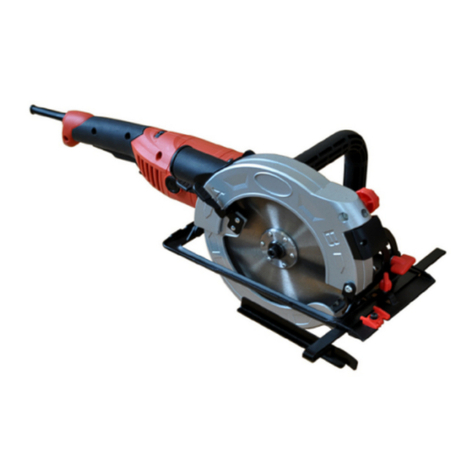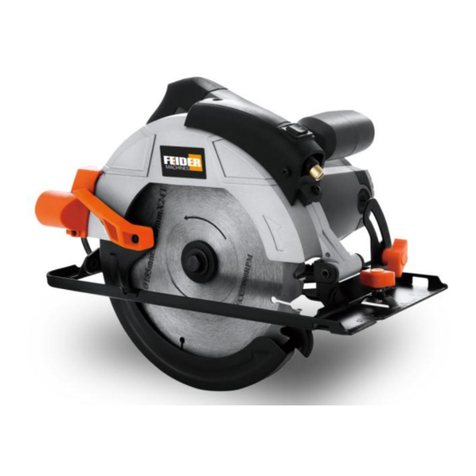Feider Machines FSOR254S2L User manual

ORIGINAL INSTRUCTIONS
Instruction manual
MITRE SAW
FSOR254S2L
WARNING: READ THE FOLLOWING INSTRUCTIONS BEFORE USE THIS MACHINE
BUILDER SAS
32, rue Aristide Bergès - ZI 31270 Cugnaux – France
MADE IN PRC
1

ORIGINAL INSTRUCTIONS
1. SAFETY INSTRUCTIONS
General power tool safety warnings
WARNING Read all safety warnings, instructions, illustrations and specifications provided with
this power tool. Failure to follow all instructions listed below may result in electric shock, fire and/or
serious injury.
Save all warnings and instructions for future reference.
The term "power tool" in the warnings refers to your mains-operated (corded) power tool or battery-
operated (cordless) power tool.
1) Work area safety
a) Keep work area clean and well lit.Cluttered or dark areas invite accidents.
b) Do not operate power tools in explosive atmospheres, such as in the presence of flammable
liquids, gases or dust. Power tools create sparks which may ignite the dust or fumes.
c) Keep children and bystanders away while operating a power tool. Distractions can cause you to
lose control.
2) Electrical safety
a) Power tool plugs must match the outlet. Never modify the plug in any way. Do not use any
adapter plugs with earthed (grounded) power tools. Unmodified plugs and matching outlets will
reduce risk of electric shock.
b) Avoid body contact with earthed or grounded surfaces, such as pipes, radiators, ranges and
refrigerators. There is an increased risk of electric shock if your body is earthed or grounded.
c) Do not expose power tools to rain or wet conditions. Water entering a power tool will increase
the risk of electric shock.
d) Do not abuse the cord. Never use the cord for carrying, pulling or unplugging the power tool.
Keep cord away from heat, oil, sharp edges or moving parts. Damaged or entangled cords
increase the risk of electric shock.
e) When operating a power tool outdoors, use an extension cord suitable for outdoor use. Use of
a cord suitable for outdoor use reduces the risk of electric shock.
f) If operating a power tool in a damp location is unavoidable, use a residual current device (RCD)
protected supply. Use of an RCD reduces the risk of electric shock.
3) Personal safety
a) Stay alert, watch what you are doing and use common sense when operating a power tool. Do
not use a power tool while you are tired or under the influence of drugs, alcohol or medication.
A moment of inattention while operating power tools may result in serious personal injury.
b) Use personal protective equipment. Always wear eye protection. Protective equipment such as
a dust mask, non-skid safety shoes, hard hat or hearing protection used for appropriate conditions will
reduce personal injuries.
c) Prevent unintentional starting. Ensure the switch is in the off-position before connecting to
power source and/or battery pack, picking up or carrying the tool. Carrying power tools with your
finger on the switch or energising power tools that have the switch on invites accidents.
d) Remove any adjusting key or wrench before turning the power tool on. A wrench or a key left
attached to a rotating part of the power tool may result in personal injury.
e) Do not overreach. Keep proper footing and balance at all times. This enables better control of
the power tool in unexpected situations.
f) Dress properly. Do not wear loose clothing or jewellery. Keep your hair and clothing away
from moving parts. Loose clothes, jewellery or long hair can be caught in moving parts.
g) If devices are provided for the connection of dust extraction and collection facilities, ensure
these are connected and properly used. Use of dust collection can reduce dust-relatedhazards.
h) Do not let familiarity gained from frequent use of tools allow you to become complacent and
ignore tool safety principles. A careless action can cause severe injury within a fraction of asecond.
3

ORIGINAL INSTRUCTIONS
4) Power tool use and care
a) Do not force the power tool. Use the correct power tool for your application. The correct power
tool will do the job better and safer at the rate for which it was designed.
b) Do not use the power tool if the switch does not turn it on and off. Any power tool that cannot
be controlled with the switch is dangerous and must be repaired.
c) Disconnect the plug from the power source and/or remove the battery pack, if detachable,
from the power tool before making any adjustments, changing accessories, or storing power
tools. Such preventive safety measures reduce the risk of starting the power toolaccidentally.
d) Store idle power tools out of the reach of children and do not allow persons unfamiliar with
the power tool or these instructions to operate the power tool.
Power tools are dangerous in the hands of untrained users.
e) Maintain power tools and accessories. Check for misalignment or binding of moving parts,
breakage of parts and any other condition that may affect the power tool’s operation. If damaged,
have the power tool repaired before use. Many accidents are caused by poorly maintained power
tools.
f) Keep cutting tools sharp and clean. Properly maintained cutting tools with sharp cutting edges are
less likely to bind and are easier to control.
g) Use the power tool, accessories and tool bits etc. in accordance with these instructions,
taking into account the working conditions and the work to be performed. Use of the power tool
for operations different from those intended could result in a hazardous situation.
h) Keep handles and grasping surfaces dry, clean and free from oil and grease. Slippery handles
and grasping surfaces do not allow for safe handling and control of the tool in unexpectedsituations.
5) Service
a) Have your power tool serviced by a qualified repair person using only identical replacement
parts. This will ensure that the safety of the power tool is maintained.
Safety instructions for mitre saws
a) Mitre saws are intended to cut wood or wood-like products, they cannot be used with
abrasive cut-off wheels for cutting ferrous material such as bars, rods, studs, etc. Abrasive dust
causes moving parts such as the lower guard to jam. Sparks from abrasive cutting will burn the lower
guard, the kerf insert and other plastic parts.
b) Use clamps to support the workpiece whenever possible. If supporting the workpiece by hand,
you must always keep your hand at least 100 mm from either side of the saw blade. Do not use
this saw to cut pieces that are too small to be securely clamped or held by hand. If your hand is
placed too close to the saw blade, there is an increased risk of injury from blade contact.
c) The workpiece must be stationary and clamped or held against both the fence and the table.
Do not feed the workpiece into the blade or cut “freehand” in any way. Unrestrained or moving
workpieces could be thrown at high speeds, causing injury.
d) Push the saw through the workpiece. Do not pull the saw through the workpiece. To make a
cut, raise the saw head and pull it out over the workpiece without cutting, start the motor, press
the saw head down and push the saw through the workpiece. Cutting on the pull stroke is likely to
cause the saw blade to climb on top of the workpiece and violently throw the blade assembly towards
the operator.
NOTE The above warning is omitted for a simple pivoting arm mitre saw.
e) Never cross your hand over the intended line of cutting either in front or behind the saw blade.
Supporting the workpiece “cross handed” i.e. holding the workpiece to the right of the saw blade with
your left hand or vice versa is very dangerous.
f) Do not reach behind the fence with either hand closer than 100 mm from either side of the saw
blade, to remove wood scraps, or for any other reason while the blade is spinning. The proximity
of the spinning saw blade to your hand may not be obvious and you may be seriouslyinjured.
g) Inspect your workpiece before cutting. If the workpiece is bowed or warped, clamp it with the
outside bowed face toward the fence. Always make certain that there is no gap between the
workpiece, fence and table along the line of the cut. Bent or warped workpieces can twist or shift
4

ORIGINAL INSTRUCTIONS
and may cause binding on the spinning saw blade while cutting. There should be no nails or foreign
objects in the workpiece.
h) Do not use the saw until the table is clear of all tools, wood scraps, etc., except for the
workpiece. Small debris or loose pieces of wood or other objects that contact the revolving blade can
be thrown with high speed.
i) Cut only one workpiece at a time. Stacked multiple workpieces cannot be adequately clamped or
braced and may bind on the blade or shift during cutting.
j) Ensure the mitre saw is mounted or placed on a level, firm work surface before use. A level and
firm work surface reduces the risk of the mitre saw becoming unstable.
k) Plan your work. Every time you change the bevel or mitre angle setting, make sure the
adjustable fence is set correctly to support the workpiece and will not interfere with the blade or
the guarding system. Without turning the tool “ON” and with no workpiece on the table, move the saw
blade through a complete simulated cut to assure there will be no interference or danger of cutting the
fence.
NOTE The phrase “bevel or” does not apply for saws without bevel adjustment.
l) Provide adequate support such as table extensions, saw horses, etc. for a workpiece that is
wider or longer than the table top.Workpieces longer or wider than the mitre saw table can tip if not
securely supported. If the cut-off piece or workpiece tips, it can lift the lower guard or be thrown by the
spinning blade.
m) Do not use another person as a substitute for a table extension or as additional support.
Unstable support for the workpiece can cause the blade to bind or the workpiece to shift during the
cutting operation pulling you and the helper into the spinning blade.
n) The cut-off piece must not be jammed or pressed by any means against the spinning saw
blade. If confined, i.e. using length stops, the cut-off piece could get wedged against the blade and
thrown violently.
o) Always use a clamp or a fixture designed to properly support round material such as rods or
tubing. Rods have a tendency to roll while being cut, causing the blade to “bite” and pull the work with
your hand into the blade.
p) Let the blade reach full speed before contacting the workpiece. This will reduce the risk of the
workpiece being thrown.
q) If the workpiece or blade becomes jammed, turn the mitre saw off. Wait for all moving parts to
stop and disconnect the plug from the power source and/or remove the battery pack. Then work
to free the jammed material. Continued sawing with a jammed workpiece could cause loss of control
or damage to the mitre saw.
r) After finishing the cut, release the switch, hold the saw head down and wait for the blade to
stop before removing the cut-off piece. Reaching with your hand near the coasting blade is
dangerous.
s) Hold the handle firmly when making an incomplete cut or when releasing the switch before
the saw head is completely in the down position. The braking action of the saw may cause the saw
head to be suddenly pulled downward, causing a risk of injury.
Additional instructions
- When using the saw, wear personal protective equipment such as safety goggles or a screen,
helmet, dust mask, gloves, non-slip footwear and protective clothing
- Ensure that there is sufficient, generalized or localized lighting.
- Do not use the saw when the protective parts are not in place.
- Do not use the saw to cut metal or masonry parts.
- Do not allow persons under 18 to operate the tool.
- Ensure that users of this tool have received professional training and know how to set and use this
tool.
- Do not use the saw to cut firewood
- Remove all stumbling blocks from the work area.
- Report or record any defects as soon as possible, including the guards and the saw blade.
- Install the saw as much as possible on a work stand. Always stay on the side when the saw is
turning.
- Never use a saw blade that is cracked or deformed.
- When cutting round wood, use a clamping assembly to prevent slippage of the workpiece.
5
Table of contents
Other Feider Machines Saw manuals
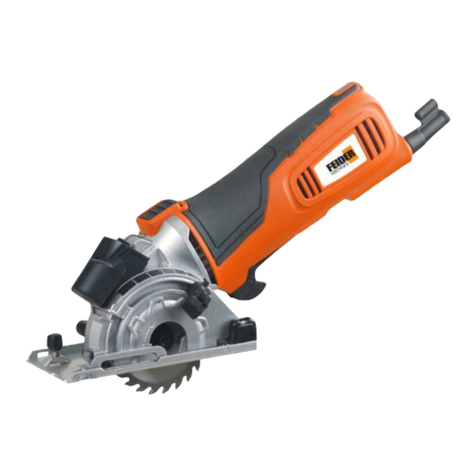
Feider Machines
Feider Machines FRX600 User manual
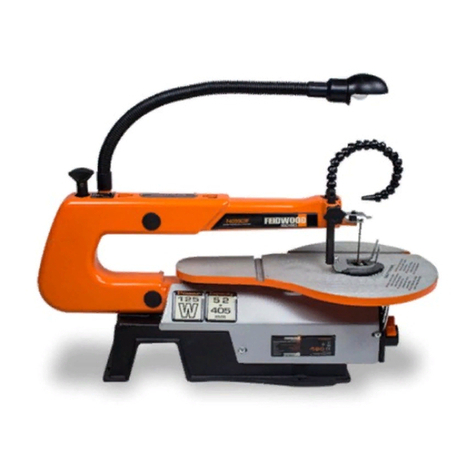
Feider Machines
Feider Machines F405SC3F User manual
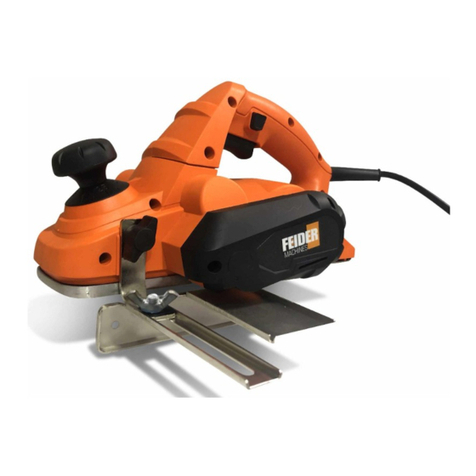
Feider Machines
Feider Machines FRB900 User manual
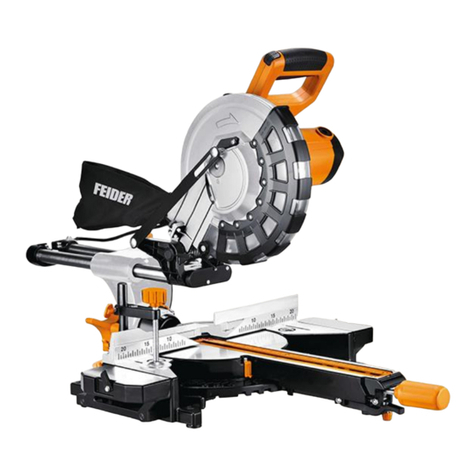
Feider Machines
Feider Machines FSOR17210 User manual
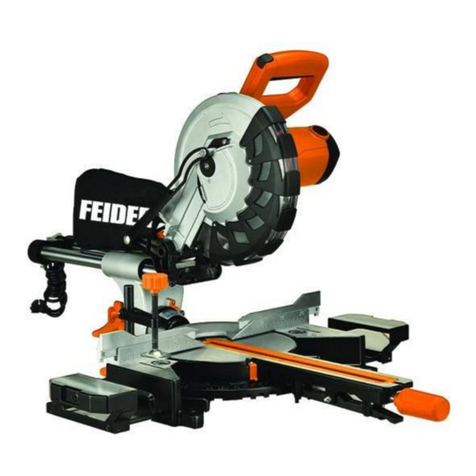
Feider Machines
Feider Machines FSOR20255 User manual
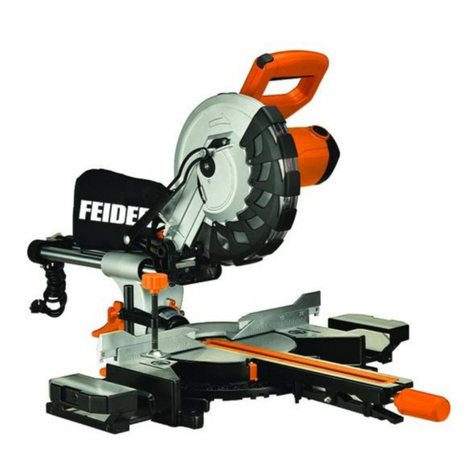
Feider Machines
Feider Machines FSO20254 User manual
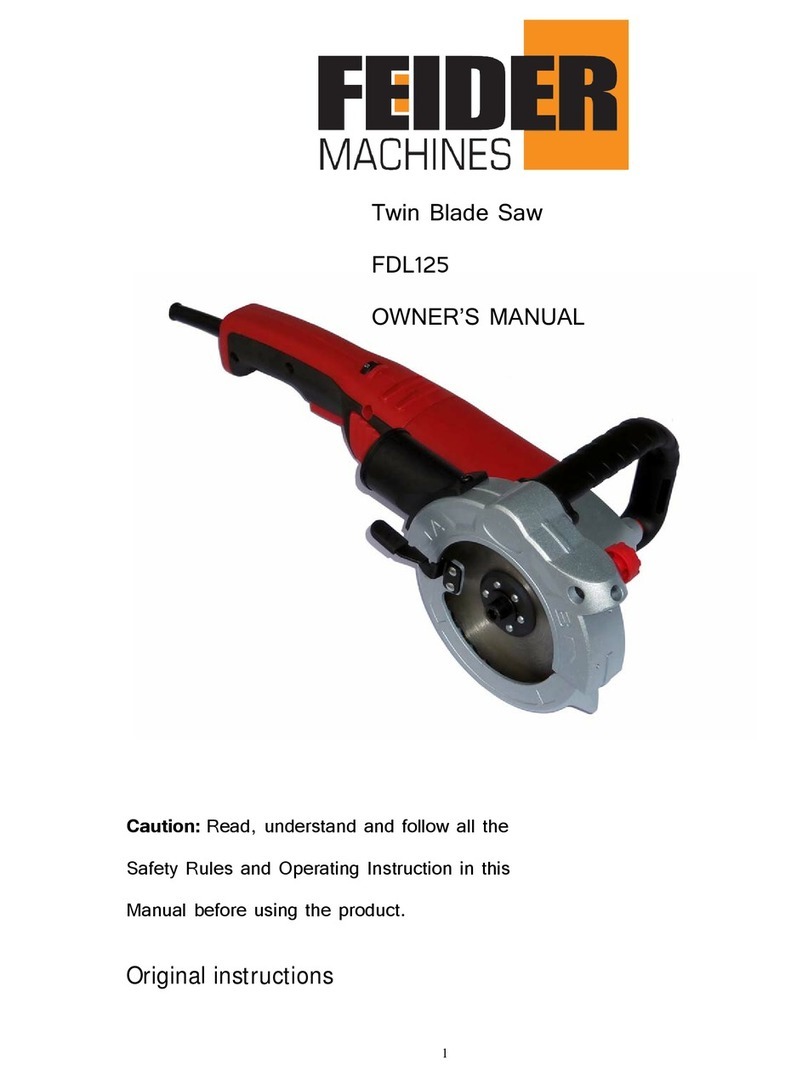
Feider Machines
Feider Machines FDL125 User manual
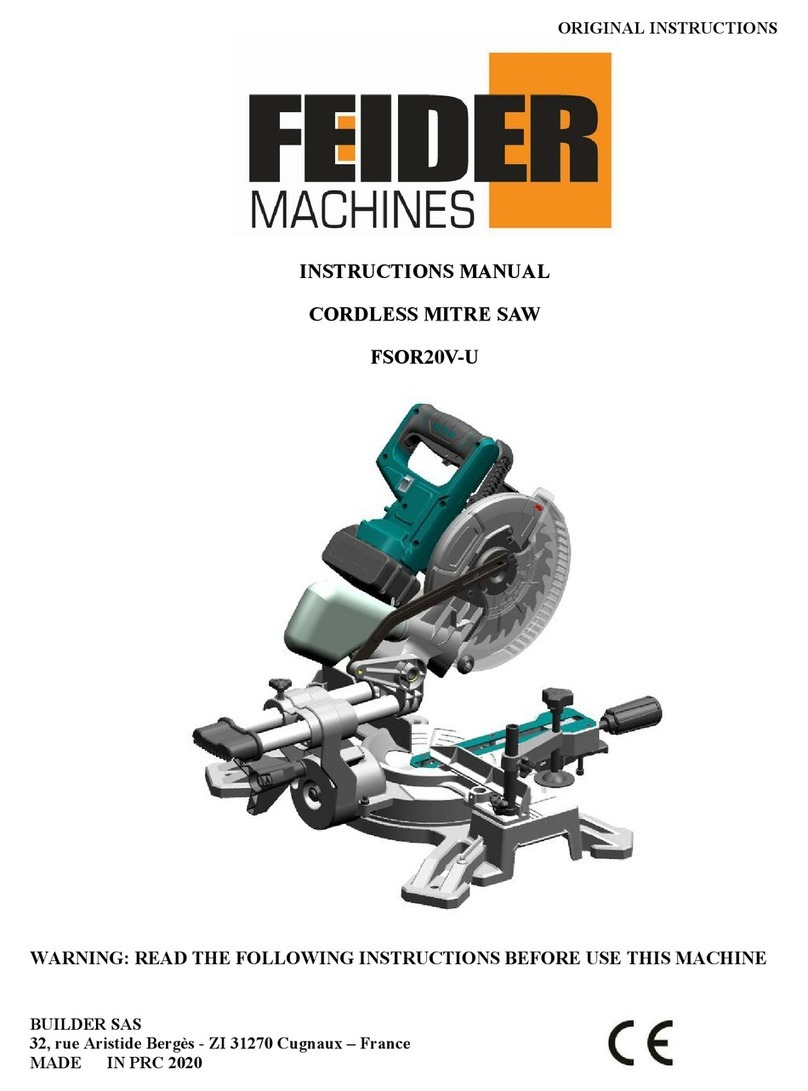
Feider Machines
Feider Machines FSOR20V-U User manual

Feider Machines
Feider Machines FSSAB20V-B User manual
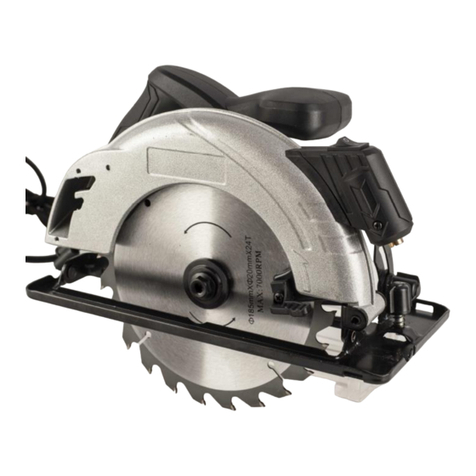
Feider Machines
Feider Machines FSC1485-B User manual

